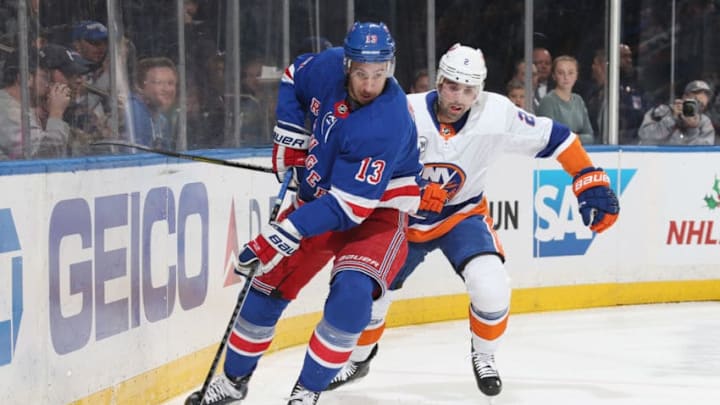
As the New York Rangers’ front office continues to work towards long-term success, decisions have to be made in a variety of different areas. Aside from simple personal choices, how much those players make is paramount.
Coming into the season, if you had told New York Rangers’ general manager Jeff Gorton that the roster he designed for a rebuilding season would be in a playoff spot on American Thanksgiving, he probably would have laughed. A far cry from the team at the end of last year, it still wasn’t exactly a group that should have lit the world on fire.
Yet, here we are in late November with the Rangers showing signs of life and flexing its muscles against decent hockey teams. While this year is a throw away in terms of expectations for the players on the ice, for the front office executives watching from upstairs it’s a litany of choices to make with serious implications.
The most obvious of all is the pending free agency of Kevin Hayes and Mats Zuccarello. Most expected either one or both of these forwards to be traded at either the NHL draft or at some point during the summer. Instead, Hayes has played like New York’s best forward and Zuccarello is nursing a groin injury.
There is an argument for both extending the two players and for trading them away. Neither is inherently right or wrong but this is more of a look at what the Rangers’ cap situation would be with one or both in the fold for at least four more years.
Hayes
Of the two, Hayes is the marquee item. A two-way center capable of playing in any situation while chipping in on offense and driving possession is every contending team’s deadline dream. As an expiring contract, the Boston native is a textbook rental for a team in need of some depth to make a playoff run.
The Rangers and Hayes agreed to a one year $5.175 million deal this past summer to avoid arbitration. Of all the team’s restricted free agents, it was the center who signed his deal last and it left an awkward tinge in the air. Make no mistake about it, a one-year bridge deal for a 26-year-old top six center is a powerful motivator.
Anytime a player is given a bridge deal, they have every incentive in the world to play out of their mind and get a massive pay raise as well as sending a message to the executive that would not lock them up long term. As clearly evident by Hayes’ 17 points in 25 games, he’s relishing his role as a leader and cornerstone in David Quinn’s lineup.
Keeping Hayes in the fold with New York would make sense as he’s still only 26. Even with a six-year deal, he’d only be 32 years old at the end of it. This would not leave the team with an aging player on the downswing of their career.
Signing Hayes would likely take a five or six-year deal for at least six million per season. That figure sounds like a lot at face value, but being that the cap goes up pretty much every single year it won’t be as much against the total cap in terms of percentage. Tying up 6.5 million in Hayes means that the Rangers would have 54 million in roster contracts.
Being that the cap ceiling was 75 million for this past season, that leaves the team with plenty of room to make further moves.
The Zuccarello situation
The hockey future for Zuccarello is one of uncertainty in the long term. As a player that’s only ever been a Ranger, he’s uniquely tied to the organization. The argument for extending the Norwegian is one of both sentimentality and production. Even at 31, Zuccarello has still managed to post 10 points in 17 games.
Skill players that rely on finesse don’t age as brutally as more physical players like the Rangers have been saddled with. The Dan Girardi and Marc Staal contracts both look as bad as they do/did because they aged in dog years. The argument for keeping Zuccarello around as a veteran who can still produce has a singular drawback.
The Rangers paying Zuccarello more than $five million per season for around 50 points may not be the best use of that portion of the salary cap. If the team could hypothetically sign a forward capable of hitting 100 points for ten million per season, that would be a better allocation of funds. 50 point players are far easier to come across than a superstar, so it’s about working that fine line.
Final thoughts
If the Rangers add an additional $11 million in cap hit to next year’s team that’d leave it with $16 million in space to sign four players to fill out the minimum to put a team on the ice. The team would likely promote players from within the organization to fill this gap and it would not be as expensive as true free agency.
Ultimately the front office will need to make the determination as to what’s more valuable, three prime years of Hayes and two decently productive years from Zuccarello or the return it’d get in a trade. That’s the way to think of trading away roster players, is their production more valuable in the immediacy than the potential of a prospect in a few years.
Roster building is both simultaneously an art and a science. G.Ms need to be able to juggle sentimental value, manage cap space and maximize the return on expiring assets. Turning Hayes into two draft picks or prospects is nice in theory, but so would three fifty point seasons from the Boston native.
There are still about two and a half months to go until the trade deadline and Gorton is going to have to consider every single pro and con of extending either or both of Zuccarello and Hayes.
